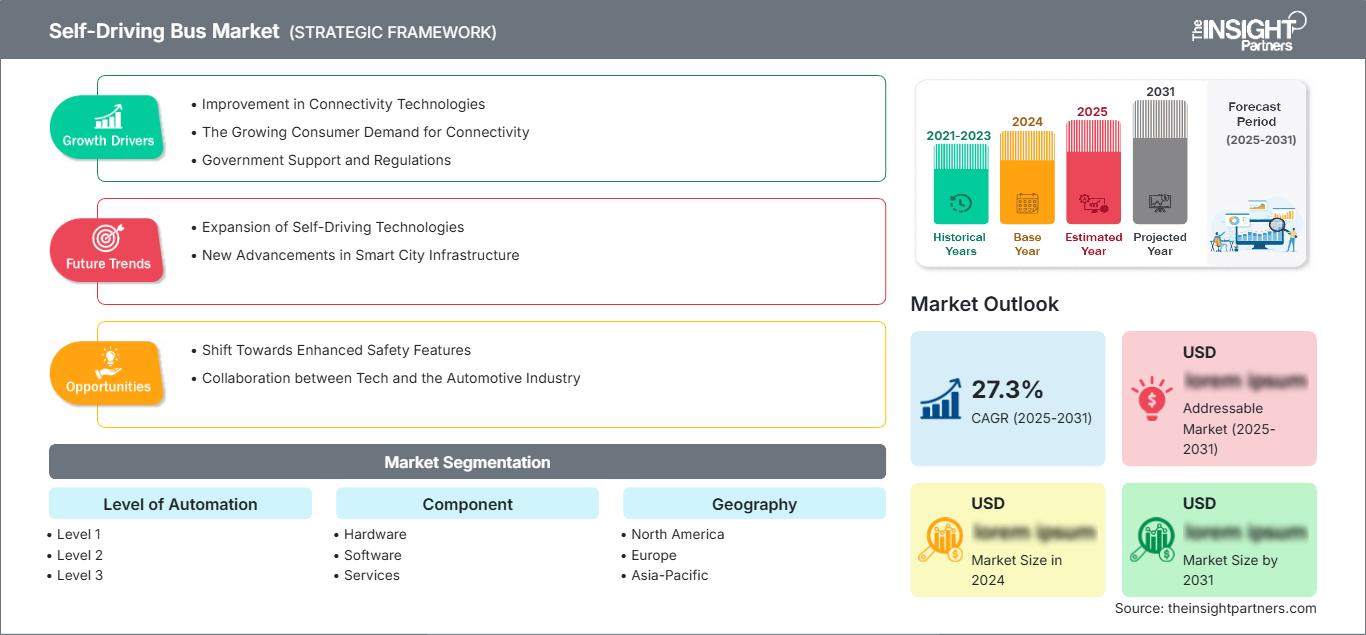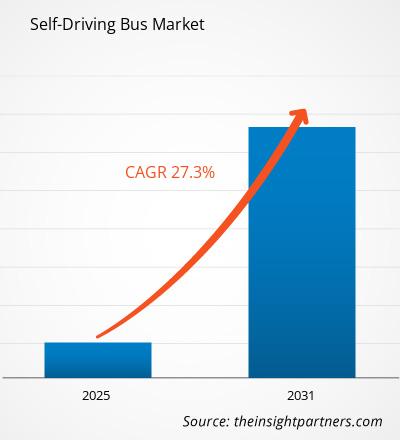Si prevede che il mercato degli autobus a guida autonoma registrerà un CAGR del 27,3% dal 2025 al 2031, con una dimensione del mercato in espansione da XX milioni di dollari nel 2024 a XX milioni di dollari entro il 2031.
Il rapporto è segmentato per livello di automazione (livello 1, livello 2, livello 3, livello 4, livello 5); componente (hardware, software, servizi). L'analisi globale è ulteriormente suddivisa a livello regionale e per i principali paesi. Il rapporto offre il valore in USD per l'analisi e i segmenti sopra indicati.
Scopo del rapporto
Il rapporto "Self-Driving Bus Market" di The Insight Partners mira a descrivere il panorama attuale e la crescita futura, i principali fattori trainanti, le sfide e le opportunità. Ciò fornirà approfondimenti a vari stakeholder aziendali, come:
- Fornitori/produttori di tecnologia: per comprendere le dinamiche di mercato in evoluzione e conoscere le potenziali opportunità di crescita, consentendo loro di prendere decisioni strategiche informate.
- Investitori: per condurre un'analisi completa delle tendenze in merito al tasso di crescita del mercato, alle proiezioni finanziarie del mercato e alle opportunità esistenti lungo la catena del valore.
- Organismi di regolamentazione: per regolamentare le politiche e le attività di polizia nel mercato con l'obiettivo di ridurre al minimo gli abusi, preservare la fiducia degli investitori e sostenere l'integrità e la stabilità del mercato.
Livello di automazione della segmentazione del mercato degli autobus a guida autonoma
- Livello 1
- Livello 2
- Livello 3
- Livello 4
- Livello 5
Componente
- Hardware
- Software
- Servizi
Potrai personalizzare gratuitamente qualsiasi rapporto, comprese parti di questo rapporto, o analisi a livello di paese, pacchetto dati Excel, oltre a usufruire di grandi offerte e sconti per start-up e università
Mercato degli autobus a guida autonoma: Approfondimenti strategici

- Ottieni le principali tendenze chiave del mercato di questo rapporto.Questo campione GRATUITO includerà l'analisi dei dati, che vanno dalle tendenze di mercato alle stime e alle previsioni.
Fattori della crescita del mercato degli autobus a guida autonoma
- Miglioramento delle tecnologie di connettività: la crescita del mercato degli autobus a guida autonoma è alimentata dal rapido progresso delle tecnologie di connettività, tra cui reti 4G, LTE e, a breve, 5G. Questi miglioramenti consentono ai veicoli di comunicare tra loro e con le infrastrutture per offrire un'esperienza di guida migliore, garantire la sicurezza e navigare su strada.
- Crescente domanda di connettività da parte dei consumatori: si registra una crescente preferenza dei consumatori per i veicoli dotati di tecnologie di connettività. I veicoli dotati di opzioni di connettività elevate hanno ottenuto un ampio consenso tra i clienti. Si osserva che i conducenti ricercano soluzioni di intrattenimento, navigazione e sicurezza a bordo che si basino su dati in tempo reale e connettività Internet.
- Supporto governativo e normative: molti governi in tutto il mondo stanno investendo in iniziative per le smart city e propongono normative favorevoli a supporto dei veicoli autonomi. Le politiche che creano un ambiente favorevole all'innovazione, in particolare nelle tecnologie dei trasporti e negli autobus a guida autonoma, favoriscono la crescita del mercato e la creazione di infrastrutture per soluzioni autonome.
Trend futuri del mercato degli autobus a guida autonoma
- Espansione delle tecnologie a guida autonoma: la combinazione di tecnologie per veicoli connessi con sistemi di guida autonoma può aprire le porte a nuove opportunità. Con l'ingresso del settore nei veicoli completamente autonomi, crescerà la necessità di soluzioni di connettività di qualità. Ciò consentirebbe tempi di percorrenza più sicuri ed efficienti. Le organizzazioni che investono in questo settore potrebbero trarre vantaggio dalla rapida crescita della tendenza verso l'automazione.
- Nuovi progressi nelle infrastrutture per le città intelligenti: gli autobus connessi promettono alla città brillanti opportunità di interazione con le infrastrutture urbane. Tali infrastrutture comprendono sistemi di gestione del traffico, soluzioni di parcheggio e reti di trasporto per veicoli pubblici. La cooperazione tra case automobilistiche e urbanisti può portare a nuove soluzioni volte a migliorare la mobilità delle persone in città e a renderla meno congestionata.
Opportunità di mercato per gli autobus a guida autonoma
- Spostamento verso funzionalità di sicurezza avanzate: Tendenze per le funzionalità di sicurezza avanzate - Maggiore implementazione di soluzioni di sicurezza avanzate nei veicoli connessi. Le funzionalità di sicurezza avanzate sono una tendenza assoluta. Sistemi anticollisione, condizioni del traffico in tempo reale e capacità di risposta alle emergenze diventano automaticamente dotazioni standard nei nuovi modelli. Ciò garantirà una migliore conformità alle normative e alle preoccupazioni dei consumatori, il che favorisce un'adozione molto più ampia delle tecnologie connesse.
- Collaborazione tra tecnologia e industria automobilistica: Esiste una crescente tendenza alla collaborazione tra aziende tecnologiche e case automobilistiche per sviluppare sistemi di guida autonoma per gli autobus. Aziende come Waymo, Tesla e i produttori di autobus tradizionali stanno collaborando per accelerare l'implementazione di autobus a guida autonoma e superare i limiti dell'automazione dei veicoli.
Mercato degli autobus a guida autonoma
Le tendenze regionali e i fattori che influenzano il mercato degli autobus a guida autonoma durante il periodo di previsione sono stati ampiamente spiegati dagli analisti di The Insight Partners. Questa sezione analizza anche i segmenti e la geografia del mercato degli autobus a guida autonoma in Nord America, Europa, Asia-Pacifico, Medio Oriente e Africa, America meridionale e centrale.
Ambito del rapporto sul mercato degli autobus a guida autonoma
| Attributo del rapporto | Dettagli |
|---|---|
| Dimensioni del mercato in 2024 | US$ XX million |
| Dimensioni del mercato per 2031 | US$ XX Million |
| CAGR globale (2025 - 2031) | 27.3% |
| Dati storici | 2021-2023 |
| Periodo di previsione | 2025-2031 |
| Segmenti coperti |
By Livello di automazione
|
| Regioni e paesi coperti | Nord America
|
| Leader di mercato e profili aziendali chiave |
|
Densità degli operatori del mercato degli autobus a guida autonoma: comprendere il suo impatto sulle dinamiche aziendali
Il mercato degli autobus a guida autonoma è in rapida crescita, trainato dalla crescente domanda degli utenti finali, dovuta a fattori quali l'evoluzione delle preferenze dei consumatori, i progressi tecnologici e una maggiore consapevolezza dei vantaggi del prodotto. Con l'aumento della domanda, le aziende stanno ampliando la propria offerta, innovando per soddisfare le esigenze dei consumatori e sfruttando le tendenze emergenti, alimentando ulteriormente la crescita del mercato.

- Ottieni il Mercato degli autobus a guida autonoma Panoramica dei principali attori chiave
Punti di forza
- Copertura completa: il rapporto analizza in modo esaustivo prodotti, servizi, tipologie e utenti finali del mercato degli autobus a guida autonoma, offrendo una panoramica olistica.
- Analisi di esperti: il rapporto è redatto sulla base della conoscenza approfondita di esperti e analisti del settore.
- Informazioni aggiornate: il rapporto garantisce la pertinenza aziendale grazie alla copertura di informazioni e dati recenti.
- Opzioni di personalizzazione: questo rapporto può essere personalizzato per soddisfare le esigenze specifiche del cliente e adattarsi in modo appropriato alle strategie aziendali.
Il rapporto di ricerca sul mercato degli autobus a guida autonoma può quindi contribuire a guidare il percorso di decodificazione e comprensione dello scenario del settore e delle prospettive di crescita. Sebbene possano esserci alcune valide preoccupazioni, i vantaggi complessivi di questo rapporto tendono a superare gli svantaggi.
- Analisi storica (2 anni), anno base, previsione (7 anni) con CAGR
- Analisi PEST e SWOT
- Valore/volume delle dimensioni del mercato - Globale, Regionale, Nazionale
- Industria e panorama competitivo
- Set di dati Excel
Report recenti
Testimonianze
Motivo dell'acquisto
- Processo decisionale informato
- Comprensione delle dinamiche di mercato
- Analisi competitiva
- Analisi dei clienti
- Previsioni di mercato
- Mitigazione del rischio
- Pianificazione strategica
- Giustificazione degli investimenti
- Identificazione dei mercati emergenti
- Miglioramento delle strategie di marketing
- Aumento dell'efficienza operativa
- Allineamento alle tendenze normative






















 Ottieni un campione gratuito per - Mercato degli autobus a guida autonoma
Ottieni un campione gratuito per - Mercato degli autobus a guida autonoma